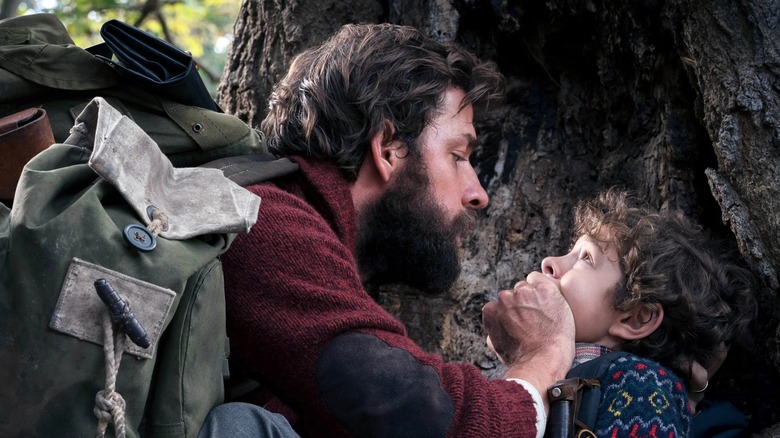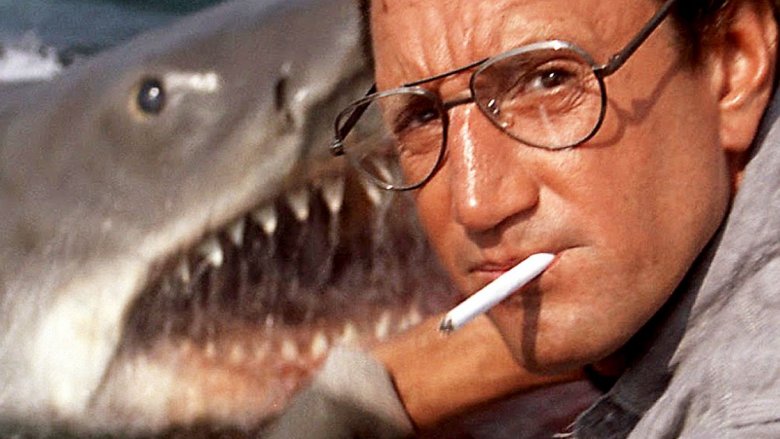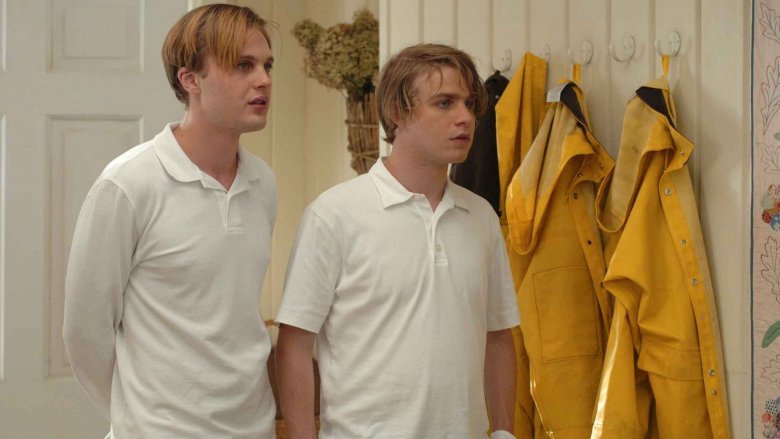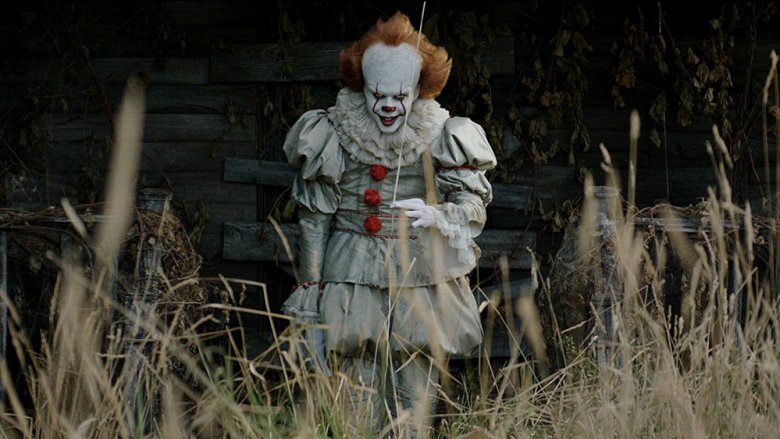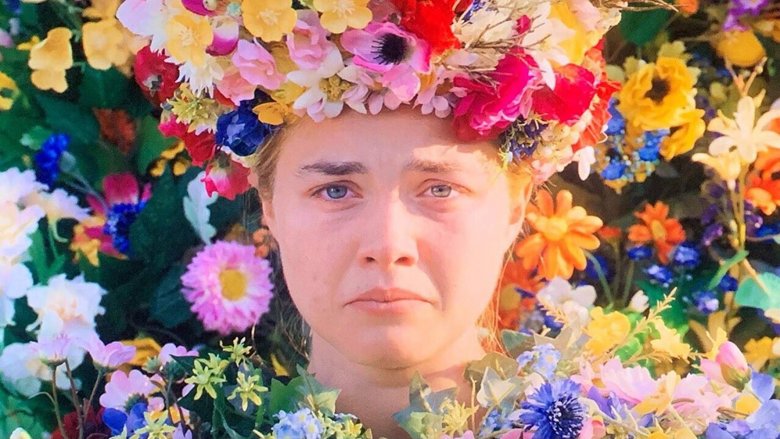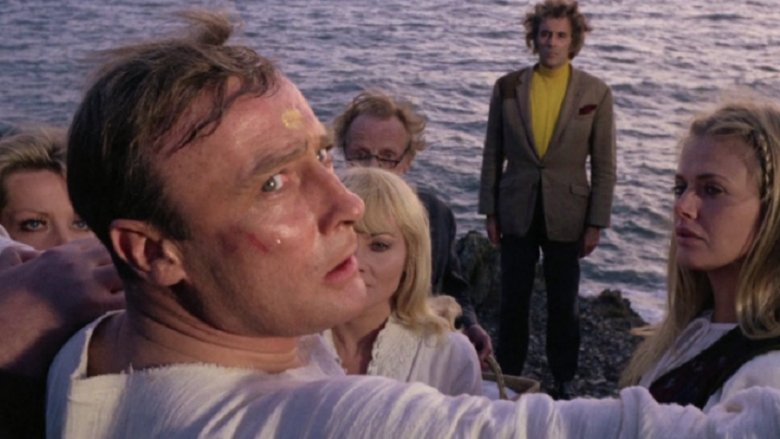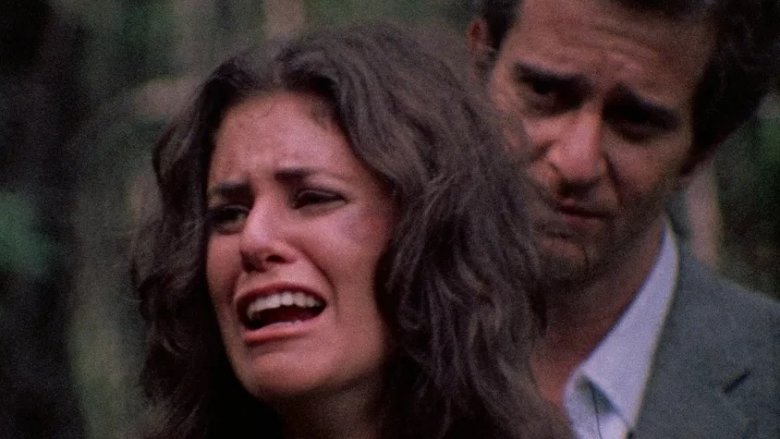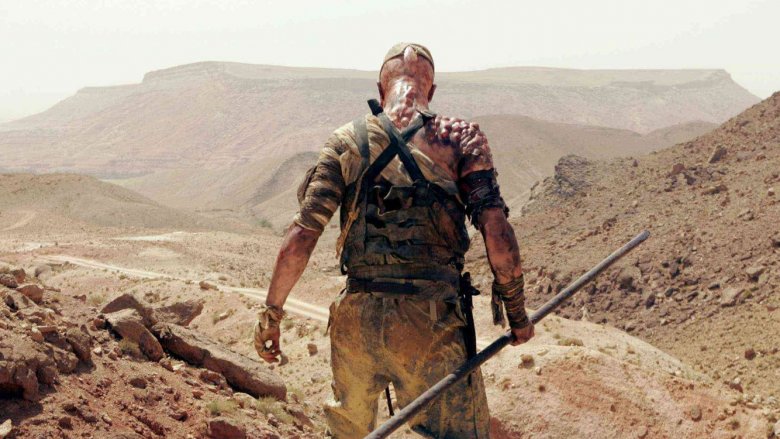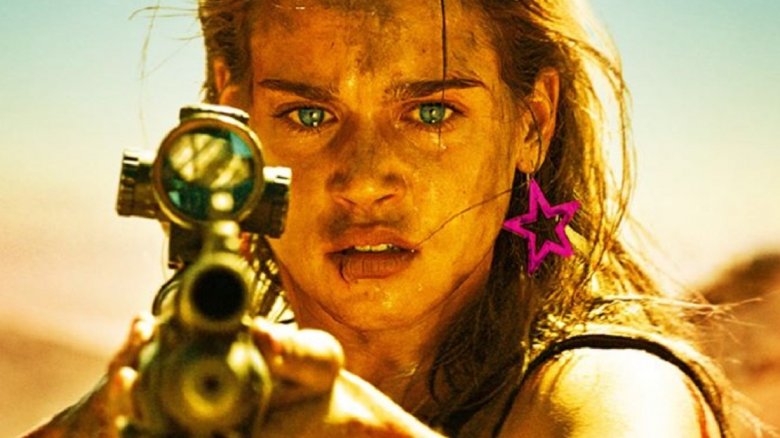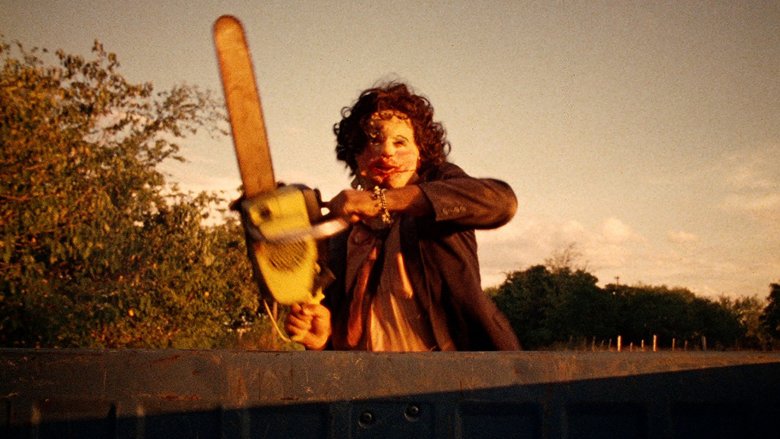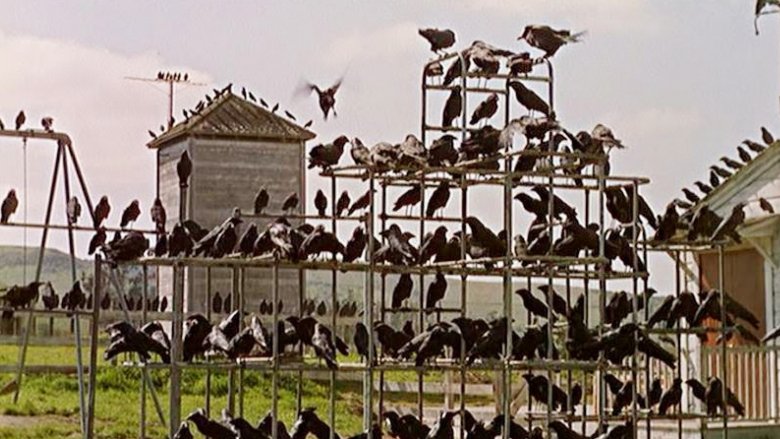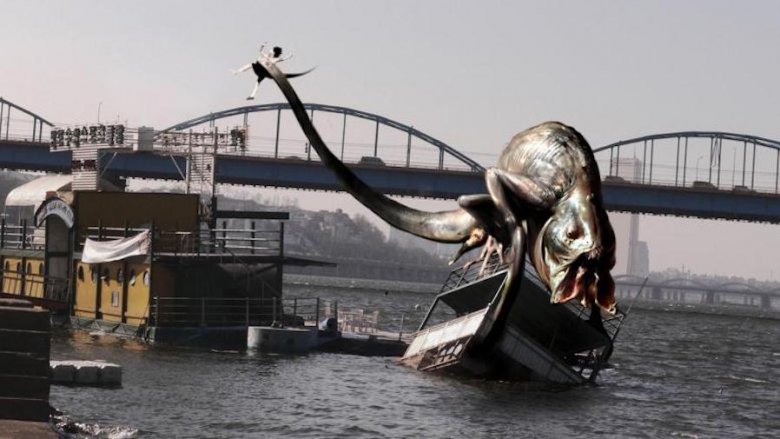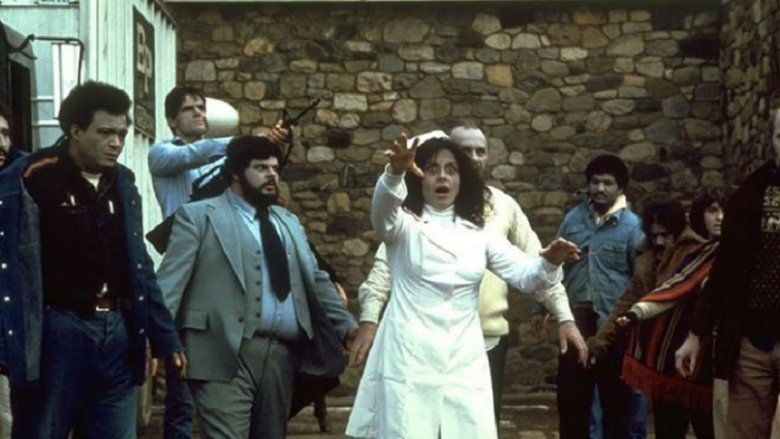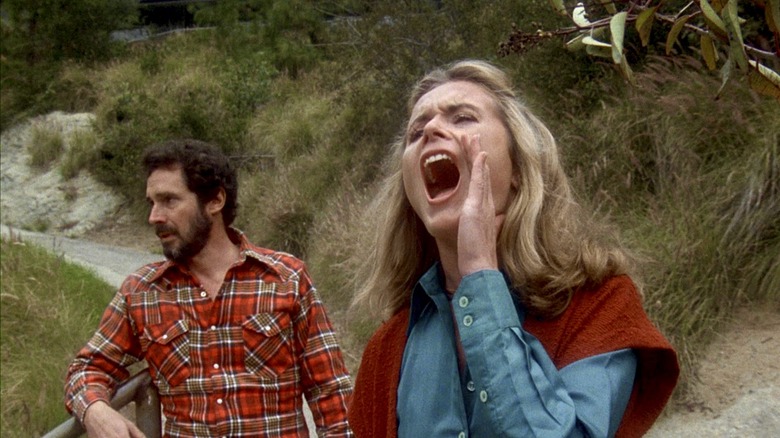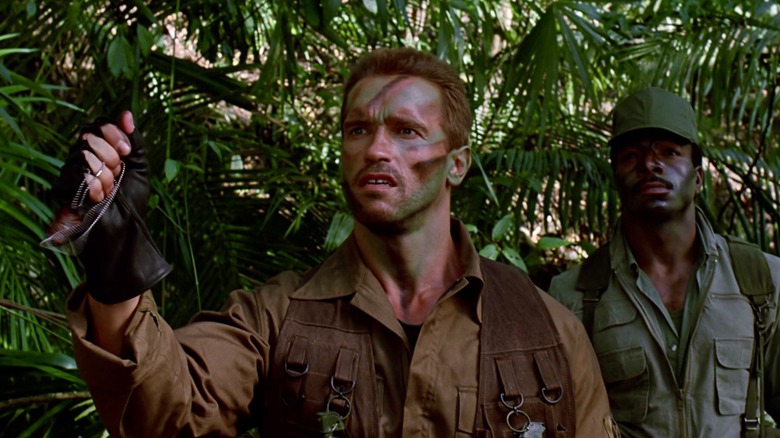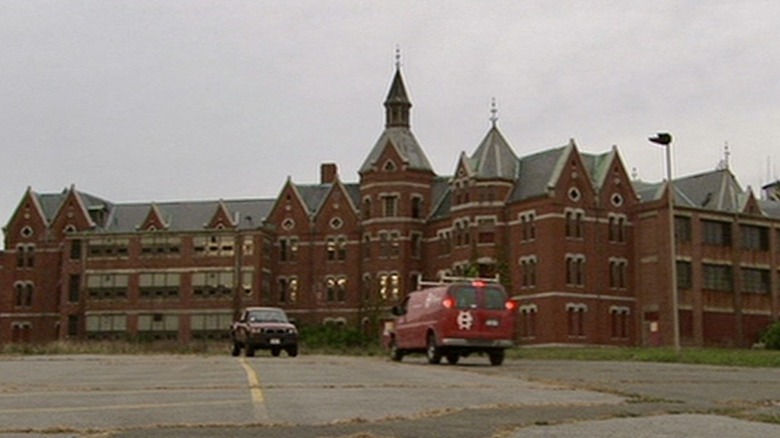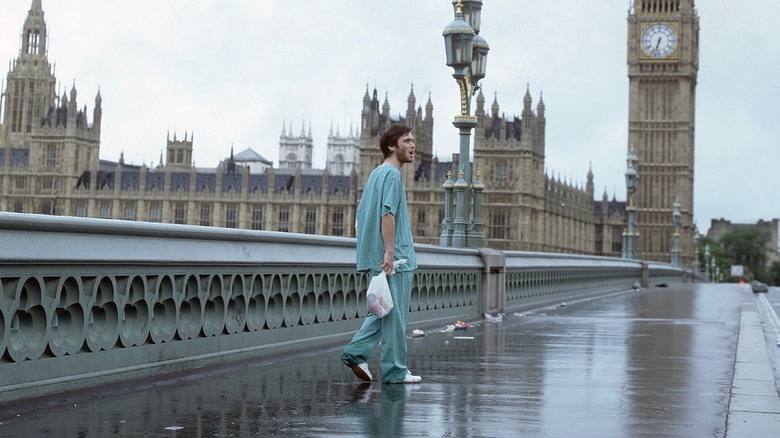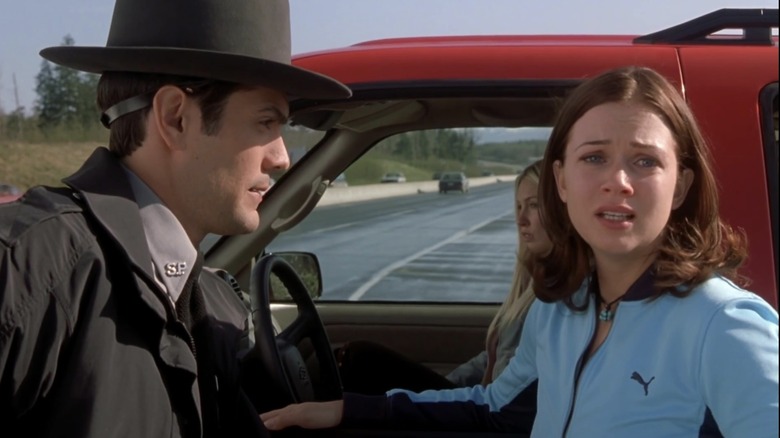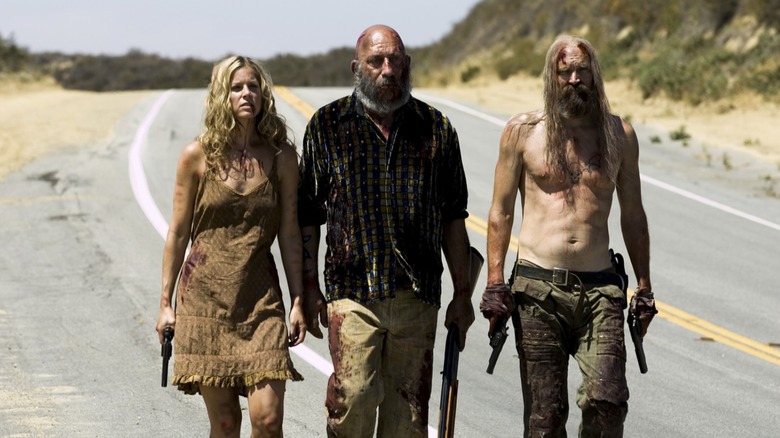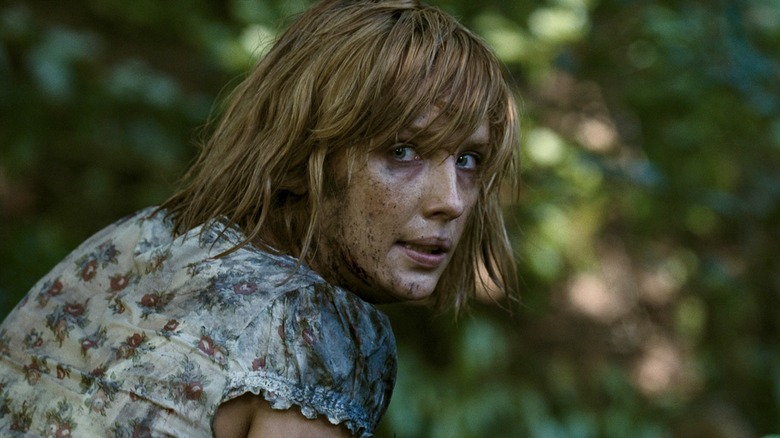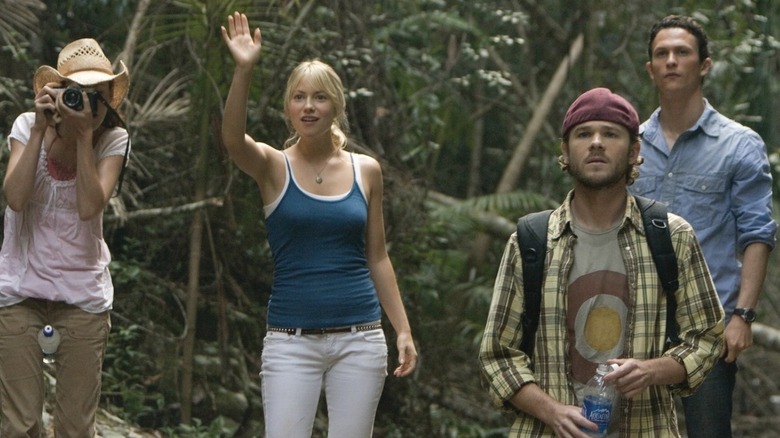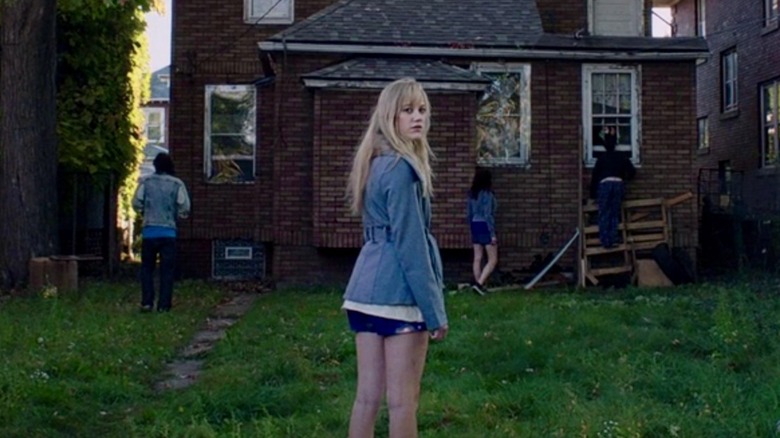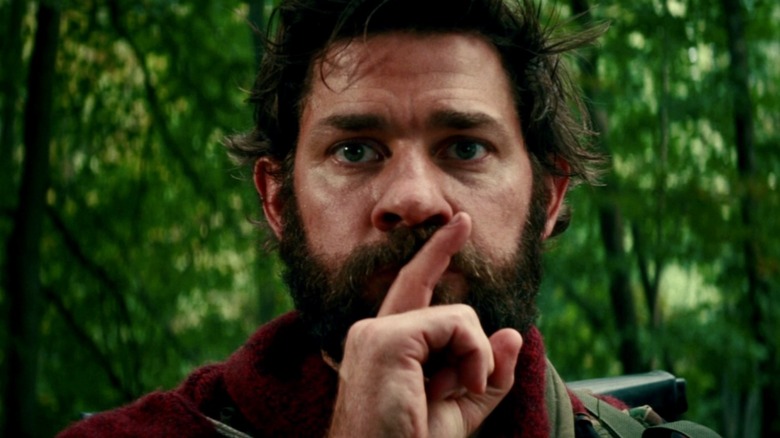The Most Brutal Daytime Horror Movies You Need To See
The horror genre is full of creepy stories about things that stab, bite, and go bump in the night. There are lots of reasons why these movies take place in the dark, but the most obvious one is that people have an inherent fear of things they can't see. And over the decades, filmmakers have gotten really good at manipulating that fear.
Of course, there's a flip side to that play-by-night approach to horror, one that understands seeing a bloodthirsty creature, a knife-wielding maniac, or a brutal act of violence in the light of day can be even more terrifying than a monster in the dark. Thus the sunny sub-genre known as "daytime horror" was born. Like every sub-genre, daytime horror has had its share of ups and downs over the years. But when a daytime horror flick makes proper use of its sun-and-blood imagery, the results are absolutely thrilling and deeply unsettling. From aquatic adventures to undead action, these are the most brutal horror movies that get their gruesome kicks with the lights on.
Jaws takes place on the sunlit sea
Ever since Steven Spielberg's "Jaws" first made the world wary of hitting the beach for some summertime fun, there's been an ongoing debate about whether or not this legendary killer shark flick fits the bill as a real horror movie. That may be because the bulk of the film — which, for the record, is totally a legit horror film — takes place in the broad light of day. Plus, many of the film's more chilling moments unfold in family-friendly environments. But really, that just amplifies the tension of the film's unseen killer.
While it's true that "Jaws" was hardly the first film to scare moviegoers by presenting its bloody mayhem in full summer light, it's certainly one of the horror films that makes the strongest use of its sun-drenched scares. That claim is only bolstered by the fact that Spielberg didn't need to front the film with gore to elicit the desired effect. Instead, he relied on an iconic bit of scoring from John Williams, the sight of a single fin breaking the waves, and a few meticulously placed jump scares to set the stage. Thanks to Spielberg's sunny yet scary vision, "Jaws" has terrified every moviegoer who's dared to wade into its choppy, red waters.
Funny Games isn't so funny during the day
German provocateur Michael Haneke has taken excessive pleasure in turning the screws on decency in service of creeping out viewers. As patently disturbing as Haneke's films are, the director has generally avoided doing straight horror, instead presenting deeply paranoid stories of relatively normal folks struggling through ominous societal discourse. Of the 12 feature films in Haneke's unsettling oeuvre, only two fully earn their horror stripes, and they just so happen to tell the exact same story.
The film in question is Haneke's nihilistic home-invasion horror show, "Funny Games", a film he first directed for German audiences back in 1997, and surprisingly revisited with the Americanized remake a decade later. If you've suffered through either version of "Funny Games" — or if you're one of the masochistic gluttons who've seen both — then you know the film spends the bulk of its button-pushing narrative watching a pair of clean-cut sociopaths terrorize an innocent suburban family for no reason whatsoever. Both films are especially uncomfortable because Haneke frequently implicates his audience in the terrors on-screen. After all, we are watching this awful stuff go down.
What horror fans may not remember — especially given the film's unfathomably dark tone — is that "Funny Games" begins with an awkward-yet-neighborly visit in the golden glow of an afternoon sun that eventually begets the film's brutality. And on top of that, after a truly torturous evening, the film's emotionally punishing finale unfolds under the crisp, overcast glow of daybreak.
We can see all the horror happening in It
Few authors have terrified as many readers and created as many memorable monsters as genre maestro Stephen King. While the famed horror scribe has dedicated a lion's share of scares to creatures and killers running amok in the cover of night, it's worth nothing that he's dedicated just as much time to exploring the profound unpleasantries of things that go bump in the waking hours. For proof, visit some cinematic adaptations of his work like "Cujo," "Children of the Corn," "Pet Sematary," and "Silver Bullet." And of course, there's the pitch-perfect 2017 adaptation of King's killer clown classic, "It."
A fear-hungry, subterranean demon, Pennywise is the stuff of nightmares. Scarier still, his unseemly antics are especially terrifying because he's often active during the daytime. There's the grueling opening moment with poor Georgie, the shock of seeing that dismembered arm wave, and don't forget about all those floating red balloons. This stuff would be bad enough in the dark, but they're made even more disturbing in the seemingly endless summer light of Derry, Maine.
Midsommar is some super gory daytime horror
Barely a year after setting our collective souls ablaze with the incendiary horror flick "Hereditary," Ari Aster unleashed another soul-shattering experience on genre lovers with his sophomore flick, "Midsommar." Seemingly out to prove "Hereditary" was no fluke, Aster ups the anguished ante throughout "Midsommar," doubling down on the moody thrills and shocking gore, and gamely proving he was just getting warmed up when he left heads rolling in the wake of his debut film.
If you're wondering just how Aster managed to eclipse the horrors of "Hereditary," well, the solution was quite simple: If "Hereditary" scored lots of scares in the dead of night, "Midsommar" would do the same in the golden light of day. As such, Aster boldly set his latest nightmare among the sun-soaked vistas of a way-off-the-map Swedish village, one whose legendary midsummer festival coincides with the land's yearly "midnight sun."
Into that sun-soaked narrative, Aster drops a group of doomed young Americans, a bear in a cage, and a sense of impending doom fit to unnerve even the staunchest genre vets. He then pumps his troupe of tragically naive characters full of powerful psychedelics, and captures every gory misfortune that befalls them in glorious sunlight — all but ensuring the film's savage imagery will stay burned into your brain for days after.
The Wicker Man is full of sunny scares
Ari Aster is hardly the first filmmaker to twist a stranger's visit to foreign lands into a pagan-tinged nightmare. Point of fact, British filmmaker Robin Hardy actually beat Aster to that prickly punch by a good 40-plus years with 1973's human sacrifice thriller "The Wicker Man." And yes, before the bee-infested version with Nicolas Cage sullied its good name, "The Wicker Man" was a legit touchstone film for both the "cult horror" and "sunny scary" sub-genres.
Granted, the plots of both "Wicker Man" movies are relatively the same, but the original is grounded, haunting, and will leave you shaken to the core. The razor-sharp screenplay by Anthony Shaffer is largely responsible for the film's effectiveness, with the scribe coolly leading viewers into a troubling missing person mystery, before pivoting toward an inflammatory battle of wits and religious beliefs. That battle pits Summerisle's pagans against a naive Christian police officer who finds out tragically late that he's been had. Of the shocking finale, we'll simply offer that the sun plays a key role, and not just because it's majestically lighting the insanity of the scene below.
We can't look away from The Last House on the Left
Wes Craven made his name directing the ultimate "night comes for us" horror show in 1984's "A Nightmare on Elm Street," but the fact is that he'd already been terrifying audiences for a full decade-plus before Freddy Krueger helped him cross over. Even if Craven didn't officially break out until "Elm Street," his preternatural gift for bringing nightmares to life was well on display from his very first film.
That particular movie was 1972's "horror comes to the suburbs" chiller "The Last House on the Left." The film follows a pair of teenage girls who leave the supposed safety of suburban life to catch a rock show in the big bad city. All is going according to plan until the pair set out to score a joint, and fall into the spidery grasp of escaped convicts, who promptly kidnap and brutalize the girls in ways we're definitely not going to describe.
Craven's harrowing "The Last House on the Left" earned itself quite a reputation for the deeply uncomfortable "reality" of those heinous acts, because Craven captured the savage brutality of each in the half-light of forested day. It's also worth noting that — though the film is bookended by moments of nocturnal nastiness — the well-lit nature of those pivotal acts help twist them into the sort of galvanizing images that you simply can't unsee.
The Hills Have Eyes takes place in a sun-scorched desert
"The Last House on the Left" wasn't the last time Craven bathed vile acts in the light of day. In fact, he'd return to the "sunny scary" side of horror pretty regularly throughout his career, with horror flicks like "The People Under the Stairs" and the "Scream" series, though he'd never do it quite as effectively as he did in 1977's "vacation gone horribly awry" freak show, "The Hills Have Eyes."
Now, before we proceed, we're happy to acknowledge that some of the most terrifying scenes in "Hills" occur at night — especially when a clan of cannibalistic, cliff-dwelling mutants lay siege to an unsuspecting family's trailer. But when the sun comes up, and the survivors fight back, Craven amps up the tension and ensures that we've got shocks-a-plenty.
For Alexandre Aja's gore-centric 2006 remake, the director kept the bones of Craven's story, but had little use for the more nuanced approach Craven brought to the original. In reality, Aja completely cast aside tone in favor of gore and ghastly makeup effects. He did, however, note the effectiveness of the sun-baked landscape in Craven's film, setting more of his untoward tale in the daytime, and thus making sure you see more grisly violence and mutated faces than you can stomach.
Revenge is a tale of burning anger and a broiling sun
If stylized, hyper-violent stories of survival unfolding within hazy desert landscapes are your cup of tea, you're going to want to add Coralie Fargeat's "Revenge" to your watch list. And believe us when we say that Fargeat's nerve-wracking tale of hunters becoming the hunted makes as dramatic use of its unforgiving, sun-drenched desert vistas as "Lawrence of Arabia." It also might have more fake blood than any other horror flick or revenge movie ever made.
For the record, that arty/gory combination makes "Revenge" a perfect daytime horror confection. At the center of the action is a young party girl who has her sexy weekend getaway with her very married beau interrupted by the arrival of some dimwitted hunters. A despicable act of sexual violence pits the woman against her deplorable male counterparts, and, well, you know what they say about a woman scorned, right?
After she's left for dead in the suffocating desert sun, our battered hero unleashes the beast within and turns into a cold-blooded killing machine bent on exacting brutal vengeance against the men who wronged her. Amid the fervid bloodletting, Fargeat frames every violent act in the glorious light of the Moroccan sun, which often feels as much a villain as the bad guys themselves.
The Texas Chain Saw Massacre is all about death during the day
When "The Texas Chain Saw Massacre" hit theaters in 1974, moviegoers must have felt like they'd inadvertently walked into a screening of a legit snuff film. And even if modern audiences know all the behind-the-scenes stories surrounding Tobe Hooper's film, the ultra-gritty tale of psychotic cannibals laying waste to a group of youngsters somewhere in the wilds of Texas still maintains a staggering sense of hyper-reality today.
Sure, budgetary restraints were chiefly responsible for the grease and grime that paint every frame of Hooper's gore-forward opus, but the fact remains that all that sweat and dust is eerily visible because Hooper shot so many of those images in the punishing light of the Texas sun. While we're fully aware that some of the more grotesque moments in "The Texas Chain Saw Massacre" unfold at night (see that stomach-churning "dinner" scene), the ones that tend to resonate most — Pam getting snatched up through the door, or blood-soaked Sally screaming as Leatherface wildly swings his weapon through the air — remain forever burned in our subconscious because the sunlight lets us see them all so clearly.
The Birds shows our feathered friends in a new light
Throughout his historic, decades-long career, there weren't many topics that the iconic horror-loving Alfred Hitchcock didn't cover. However, while the legendary filmmaker took obvious pleasure in finding new, gruesome ways to dispatch with his characters onscreen, Hitchcock had never really done so via the time-honored, B-movie bombast of a creature feature. Of course, that all changed when Hitch unleashed "The Birds" on the moviegoing public in the spring of '63, and the world has never looked at our feathered friends the same way since.
"The Birds" follows a young socialite who follows her would-be beau to a small Northern California town, only to see the village overrun by flesh-hungry birds from many different flocks. Yeah, it sounds a bit silly, but while the effects are dated, there's a whole lot to like about Hitchcock's harrowing tale of survival. After all, it's a story that makes giddy use of California sunlight to build a seriously eerie "calm before the storm" vibe. Hitchcock then unleashes the feathered beasts, capturing every manic moment thereafter through a sun-fused, Technicolor-tinged haze that'll probably make you think twice about heading west to see one of those famed California sunsets.
The Host certainly doesn't try to hide its monster
Directed by Bong Joon-ho, "The Host" is a merciless, hilarious creature feature that sets its beastly action almost entirely in broad daylight. The movie finds a particularly nasty foe wreaking havoc over a peaceful, waterside setting (the Han River), a space full of everyday people soaking in the rays. While the daytime setting surely complicated matters for the film's effects team (how often do we actually see such creatures in the light?), the impact of seeing their vividly detailed, flesh-devouring, fish-type-thing running amok on the sunny river banks is nothing short of incredible. The strategy of unleashing such a savage monster in the midday sun — thus highlighting the ensuing carnage — helps "The Host" transcend its B-movie roots to become the ultimate sunlit monster movie.
Making "The Host" even more intriguing is the fact that the story (which opens with a U.S. doctor ordering a large amount of formaldehyde be dumped into the Han) was inspired by a real event that took place in Seoul circa the year 2000, though there has yet to be a single report of any monstrous, amphibious creatures emerging from the mighty river.
Dawn of the Dead is daytime horror at its undead best
Sure, George A. Romero's genre-birthing, 1968 zombie flick "Night of the Living Dead" actually has the word "night" in the title. Yes, it follows a group of disparate strangers as they spend a torturously long evening fending off undead hordes. But it's worth noting that one of the black and white film's scariest scenes (that iconic "they're coming to get you, Barbara" opening) is set in the middle of the day, which bolsters its creep-factor beyond infinite.
The power of that moment clearly resonated with Romero, and may be the reason for all the daytime scenes in his followup, 1978's "Dawn of the Dead." Because even if "Dawn" spends the bulk of its narrative taking aim at consumerist culture in the confines of a largely abandoned shopping mall, the film spends ample time watching undead beasts dismember humanity in full daylight — with the human characters observing all manner of mayhem (and sun-baked zombie flesh) from the sunny rooftop of that mall.
Seeing those undead hordes in the daytime was effective to say the least, and you can be certain Zack Snyder had those hauntingly bright visuals in mind when he set out to direct 2004's "Dawn of the Dead" remake. He even went so far as to bathe the film's appallingly gruesome opening moments in the golden light of morning, and spent the entirety of a shocking mid-credit sojourn to a deserted island in the light of day, which only made that final image on the docks all the more punishing to witness.
Piranha is gory fun in the sun
No daylight horror list is complete without "Piranha," a tongue-in-cheek "Jaws" spoof that is as entertaining as it is bloody. When Maggie (Heather Menzies-Urich), a private investigator looking for two teenagers who went missing while backpacking, teams up with Paul (Bradford Dillman) as her reluctant local guide, she unwittingly releases fish that the military genetically modified from an abandoned research facility.
After that, the race is on to beat the killer fish to a summer vacation spot and a summer camp downriver. While the special effects and feeding frenzy scenes aren't technologically advanced, the bloody water and fish ripping chunks of flesh off their victims as they scream is effective, and staging an attack on children at summer camp is a bold choice.
The children's panicked shrieking as they flee the river, while their cantankerous camp counselor, Mr. Dumont (Paul Bartel), covered with bites and blood, risks life and limb to lift the children out of the water and onto dry land is fantastic. The ominous ending, suggesting that the piranha make it to the ocean and are designed to survive salt water, is a classic horror finale. This horror-comedy is funny, gory, and doesn't take itself too seriously, which is a big part of its charm and popularity with audiences. Joe Dante's "Piranha" is a sun-soaked must-see for fans of daylight horror.
Predator is a genre-bending creature feature set in the jungle
"Predator" usually goes in the sci-fi or action category, but it is also a stellar creature feature and a genre-bending horror masterpiece. Dutch's (Arnold Schwarzenegger) explosive confrontation with the homicidal alien might happen under the cover of darkness, but the cat-and-mouse game the alien plays while picking off Dutch's comrades one by one happens during daylight under the canopy of the Amazon jungle.
This not only allows us to see all the carnage but also tricks the audience into believing they are watching a straightforward action movie. As the alien hunts the commandos through the jungle while they march toward their rendezvous with an extraction chopper, the horror tropes become more pronounced. The alien stalks its prey when they separate from the group as killers in slasher films do. The violence is extra gory, like Blaine's (Jesse Ventura) horrific blown-out chest cavity. Even the alien being unmasked for its final confrontation with Dutch is a standard slasher trope.
Looking back at the beginning of "Predator," some of these horror elements are present from the beginning; we just didn't know to look for them. For example, the jump scare the audience experiences when the group discovers the alien's first victims hanging upside down from trees with their skin flayed off is a horror tactic. The alien from "Predator" is one of cinema's most terrifying monsters — largely because he moves invisibly in broad daylight.
Session 9 is a nasty construction job turned daytime nightmare
"Session 9" follows a hazardous materials clean-up crew removing asbestos under a tight deadline from an abandoned asylum. Mike (Stephen Gevedon) becomes obsessed with therapy session tapes of a patient suffering from dissociative identity disorder, while Jeff (Brendan Sexton III) spends his time terrified of the generator turning off and being trapped in the darkness. Self-centered Hank (Josh Lucas) is preoccupied with a cache of collectible coins he finds in the tunnels under the building, while Phil (David Caruso) is worried about Gordon's (Peter Mullan) deteriorating mental state. Gordon is overwhelmed by his struggling business and life as a new father.
The real-life Danvers State Mental Hospital is creepy in the same way the Overlook Hotel or Hill House is. True to gothic horror tropes, Danvers and its bizarre history have a destabilizing effect on the crew's mental state. "Session 9" relies on suspense and visceral dread more than it does on gore or jump scares, although it does employ those horror tactics sparingly.
Since the story follows a work crew, it takes place during the day. The sunlight leaking through the grimy windows reveals the squalor in the architectural monstrosity and adds to the unease that permeates this film. The ambiguous ending leaves audiences wondering if Danvers pushed our killer over the edge and violence was already lurking in his heart, or if Danvers really does house a malevolent entity — calling itself Simon — that preys on the weak and wounded.
28 Days Later is a haunting dystopian vision in the daylight
Although the climactic confrontation in "28 Days Later" takes place in the dark and rain, much of the film takes place during the day. The opening scenes of Jim (Cillian Murphy) waking up in a bright yet abandoned hospital before wandering through a trash-strewn, eerily empty London builds dread in the audience. When Jim is attacked by infected humans who have transformed into zombie-like creatures, then saved by survivors who firebomb the zombies, we know this horror movie is something unique.
Director Danny Boyle plays with horror conventions by making his zombies fast and setting his story during the day, where you can see just how gruesome the zombies are. Similarly, the opening chase sequence in the sequel, "28 Weeks Later," is terrifying and also takes place in broad daylight so you can see how disgusting and fast the zombies are.
In a world overtaken by the infected, the only safe time to travel is during the day when you can see your surroundings, making daylight essential to telling this post-apocalyptic tale about the horrors humans must perpetrate to survive the destruction of their society. "28 Days Later" kicked off a zombie renaissance, bringing the sub-genre back to life, and proved daylight is just as terrifying as night.
Final Destination 2 features the screen's most brutal multi-car accident
The opening highway car crash scene in "Final Destination 2" probably traumatized a generation of inexperienced teen drivers and induced driving anxiety in some audience members for years after seeing the movie. Part of the reason it works so well is that it takes place in the morning during rush hour traffic, where we can see every awful collision, explosion, and splatter of blood. While the first film mostly took place at night, the sequel is the strongest of four follow-ups in this horror franchise and uses the daylight setting to its advantage.
"Final Destination 2" also boasts the most elaborate deaths in this absurd but entertaining series. Anyone who has seen the sequel thinks twice when they step into an elevator or sit in a dentist's chair. At times, the sequel seems like a satire of the first film. Death is portrayed as having a twisted sense of humor and enjoys playing with its prey, which was an element missing from the first film. "Final Destination 2" is gory, funny, inventive, and revels in absurd horror conventions, which is something you must embrace while binging the "Final Destination" franchise.
The Devil's Rejects is a bloodbath under the scorching sun
Rob Zombie's follow-up to "House of 1000 Corpses" opens with a law enforcement raid on a dilapidated farmhouse where Sheriff Wydell (William Forsythe) finds evidence of over 75 murders. This violent, vile film follows the remaining members of the Firefly family, Baby (Sheri Moon Zombie) and her brother Otis (Bill Moseley), who escape capture before taking a traveling band hostage at a rundown roadside motel.
After meeting up with their father, Captain Spaulding (Sid Haig), the psychopathic trio embarks on a killing spree under the scorching Texas sun, while Sheriff Wydell embraces his darker nature by torturing and killing the matriarch of the Firefly family (Leslie Easterbrook) at the jailhouse. "The Devil's Rejects" is unrelenting, featuring the nastiest road-kill scene you have ever witnessed, with every disturbing detail highlighted by the stark desert sunlight. "The Devil's Rejects" is a sun-drenched love letter to '70s horror movies that revels in the genre's depravity, gratuitous violence, and nudity.
If you love slasher films and haven't seen "The Devil's Rejects" yet, you're missing out on a solid entry to the daylight horror subgenre. Even Roger Ebert acknowledged this brutal film's merits in his three-star review, highlighting the film's dark humor as a selling point for horror fans.
Eden Lake is a weekend lakeside getaway turned deadly
"Eden Lake" is the intersection of "hoodie" and "daylight" horror, following a middle-class English couple, Jenny (Kelly Reilly) and Steve (Michael Fassbender), on a romantic lakeside vacation to a remote campsite slated for development. After Steve's heartfelt marriage proposal, local teens from the nearby working-class community antagonize Jenny and Steve, leading to increasingly violent altercations between the outsiders and local teens.
Once the situation has turned deadly and the children have captured and tortured Steve at the behest of their de facto leader, Brett (Jack O'Connell), writer-director James Watkins expertly uses the daylight forest setting, which makes it difficult for Jenny to save Steve or hide from their tormentors. Their geographical isolation only intensifies the terror Jenny and Steve experience while fighting for their lives, harkening back to genre classics like "Deliverance."
When Jenny finally escapes the woods, after exacting revenge on some of her adolescent tormentors, she finds a group of adults at a house party. Jenny's hopes of safety are dashed when she discovers the adults are the parents of the children she fought in the woods. The film argues that the teens' violent behavior is learned from their abusive parents. "Eden Lake" is a harrowing, violent exploration of classism and "Broken Britain," exploring the dangers of teenage boredom experienced during endless, unsupervised daylight hours.
The Ruins is a vacation from hell under the Yucatan sun
When a group of friends vacationing in Mexico follow a German backpacker off the beaten path and into the Yucatan jungle in search of Mayan ruins, their idyllic vacation becomes a desperate fight for survival. After finding the Mayan pyramid, the local tribe attacks the group of tourists, and they become trapped at the top of the pyramid where they must contend with injuries, little water, and the punishing sun.
But when the jungle itself turns on the tourists, "The Ruins" shifts away from a survival thriller and squarely into body horror. The vines covering the Mayan pyramid come to life, attacking and infecting the group as they lose their grip on sanity. While there are some effective scenes using darkness to instill fear, the sentient, parasitic vines are most terrifying when the story unfolds in the harsh sunlight as we see the vines strangle, infect, and kill their victims.
"The Ruins" is a macabre example of daylight horror where tourists meet a terrible fate for daring to depart the all-inclusive Mexican vacation for an adventure in the jungle. This movie features a double amputation and a beautiful girl carving herself up like a Thanksgiving turkey. There is even some social commentary about first-world travelers invading third-world countries, buried somewhere underneath all the gore.
It Follows is a creepy suburban horror story
"It Follows" might on the surface seem like an allegory for contracting an STD, as Hugh (Jake Weary) passes a curse to Jay (Maika Monroe) after they sleep together in the back of his classic muscle car. Hugh chloroforms and abducts Jay to show her the supernatural entity that will now haunt and hunt her, explaining that she must pass it on to someone else to protect herself. This creepy film effectively uses daylight to emphasize how frightening it is to be pursued by a malevolent entity that only appears visible to its victims.
The mundane suburban setting contrasts nicely with the menacing figures that follow and torment Jay, and seeing them clearly only intensifies how terrifying they are. An elderly woman in a nightgown following Jay through the halls of her college is one of the more disturbing images in the film. Although Jay's friends don't initially believe her, they finally band together to help her as a growing unease infects the audience.
While "It Follows" isn't an allegory for STDs, it certainly speaks to victims of sexual assault and stalking victims who, like Jay, live in hypervigilance. Jay is constantly scanning her surroundings, looking for a figure no one else can see, knowing the threat could come from anyone. This entity pursues Jay around the clock, but the most frightening scenes happen during broad daylight, suggesting she will never be safe.
If you or anyone you know has been a victim of sexual assault, help is available. Visit the Rape, Abuse & Incest National Network website or contact RAINN's National Helpline at 1-800-656-HOPE (4673).
A Quiet Place uses silence, stillness, and sunlight
John Krasinski's "A Quiet Place" is a horror masterpiece that is largely silent, because the terrifying aliens who invade Earth and decimate the population hunt by sound. Survivors of the invasion, like the Abbot family, live in silence, terrified of making any noise that will attract the aliens' attention. The Abbots have one advantage: because their daughter is deaf, they easily communicate using sign language.
While many horror films use the cover of darkness to induce panic and dread in the audience, effectively taking away one of our most important senses and heightening others, "A Quiet Place" builds tension and terror by showing us absolutely everything, often illuminated by daylight. Our clear vision makes the audience dread any potential source of noise because it will bring death and destruction.
It's only when everything gets quiet that we realize how noisy nature and life are. A creaking step, the sounds of footfalls, a bird's call, and the first cries of a newborn baby can draw the aliens to their door. The Abbots are expecting the birth of a child, and the challenge of a silent delivery and muffling the baby's first wails imbue the movie with unbearable tension. If you haven't seen "A Quiet Place" yet, it is an emotionally fraught, must-see daylight horror gem.
